

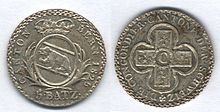
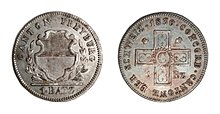
The batzen is an historical Swiss, south German and Austrian coin. It was first produced in Bern, Switzerland, from 1492 and continued in use there until the mid-19th century.




The batzen is an historical Swiss, south German and Austrian coin. It was first produced in Bern, Switzerland, from 1492 and continued in use there until the mid-19th century.
Bernese chronicler Valerius Anshelm explained the word from a folk etymology perspective saying that it came from Bëtz ("bear"), the heraldic animal of the Swiss canton, which was embossed on the reverse of the coin. The word probably goes back to Upper German (particularly Bavarian) batzen ("stick together") or Batzen ("lump, thick piece"), since it referred to a Dickpfennig ("fat pfennig"). [1]
A double Plappart , which soon became known as a Batzen, was minted in Bern from 1492. [2] The minting of Batzen in Salzburg is also attested early on, in 1495. [3]
The Batzen was originally minted in silver, but from the 17th century in billon. The value of the Batzen varied over time depending on where it was minted. The value of a Bernese Batzen initially corresponded to four Kreuzer. Since the Gulden was worth 60 Kreuzer , 1 Batzen in Bern, Freiburg and Solothurn also corresponded to one fifteenth of a Gulden. Later there were also Grossi ("thick ones", i.e. Groschen ) worth 5 Batzen. Other places of the Old Confederation and some southern German states soon followed Bern's example. Zürich minted 16 Batzen to the Gulden from 1500 onwards. In 1564, a Thaler was worth 16 Constance Batzen. [4] Around 1600, 1 Bocksthaler (Schaffhausen Thaler) was worth 17 Batzen or 68 Kreuzer, so 1 Batzen = 1⁄17Thaler = 4 Kreuzer. [5] In the early 18th century the Hohlbatzen ("hollow Batzen") was worth five Kreuzer (1/12 Reichsgulden), the regular Batzen four Kreuzer, the Basel and Zürich Batzen were valued at 1⁄18 Gulden, the St. Gallen Batzen at 1⁄17 Gulden. In the second half of the 18th century, 1 Reichsbatzen was worth 16 Pfennigs , 1 Zürich Batzen was 15 Pfennigs, 1 Bernese or 1 Chur Batzen was 14 Pfennigs. [6]
The Batzen became a widespread intermediate currency between the numerous large and small silver coins circulating in Europe. Since some of the South German Batzen were of very different quality, the Reichstag in 1522 and 1524 spoke out against these coins. In southern Germany they were minted until 1536, but were banned by the Imperial Minting Ordinance of 1559. However it was still, for example in Nuremberg, in 1564 [7] in use as a currency designation. In Switzerland, on the other hand, the Batzen went unchallenged.
In the case of some so-called Kipper coins, however, the Batzen was used to name these interim coins. In the time of counterfeiting, the Kipper and Wipper period, for example in Thuringia inter alia in the mints of Gotha (1621–1623) and Weimar (1619–1622), other Kipper coins worth three and six Batzen were minted (the Dreibätzner and Sechsbätzner). The coins could not be objected to, because they were state coins, not Thaler coins or divisions of them, which had to conform to imperial coinage regulations.
Even after the Munich Coinage Treaty of 1837, Batzen were minted as Scheidemünzen to the value of four Kreuzers in some member states, for example in the Free City of Frankfurt. The coins were in use until the introduction of the Mark in 1871. As late as 1873, the increase in the price of beer by the Frankfurt breweries from 4 to 4½ Kreuzer triggered the Frankfurt beer riot, which began with the demand "I want Batzen beer" (Mir wolle Batzebier) and led to serious social unrest.

When a Swiss single currency was introduced for the first time in 1798–1803 by the Helvetic Republic, the Batzen was also integrated into the system. One franc was worth ten Batzen, one Batzen in turn ten centimes, with 10 Swiss francs being equivalent to a Louis d'or. After the end of the single currency, coin sovereignty was returned to the cantons, some of which retained the decimal Franc-Batzen-Rappen division (Aargau, city of Basel, Bern, Freiburg, Lucerne, Solothurn, Unterwalden, Uri, Vaud, Valais, Zug). Only in the canton of Neuchâtel was a franc worth 10½ Batzen. The other cantons introduced currencies with a Gulden-Schilling or Florin-Livre system. The era of the Batzen ended in 1850 with the introduction of the new Swiss franc as the single Swiss currency. An old franc did not correspond to a new franc. Seven Batzen could be exchanged for a new franc in 1850. Meanwhile, the Batzen became a colloquial term for the 10 Rappen (10 cent) coin.
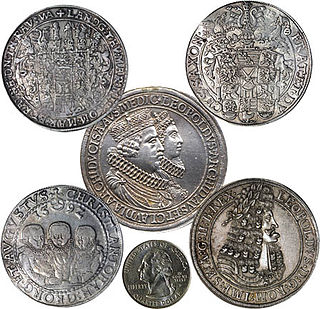
A thaler or taler is one of the large silver coins minted in the states and territories of the Holy Roman Empire and the Habsburg monarchy during the Early Modern period. A thaler size silver coin has a diameter of about 40 mm and a weight of about 25 to 30 grams. The word is shortened from Joachimsthaler, the original thaler coin minted in Joachimsthal, Bohemia, from 1520.

The Swiss franc is the currency and legal tender of Switzerland and Liechtenstein. It is also legal tender in the Italian exclave of Campione d'Italia which is surrounded by Swiss territory. The Swiss National Bank (SNB) issues banknotes and the federal mint Swissmint issues coins.
The pfennig ; symbol pf or ₰) or penny is a former German coin or note, which was the official currency from the 9th century until the introduction of the euro in 2002. While a valuable coin during the Middle Ages, it lost its value through the years and was the minor coin of the Mark currencies in the German Reich, West Germany and East Germany, and the reunified Germany until the introduction of the euro. Pfennig was also the name of the subunit of the Danzig mark (1922–1923) and the Danzig gulden (1923–1939) in the Free City of Danzig.

A Rappen originally was a variant of the medieval Pfennig ("penny") coin common to the Alemannic German regions Alsace, Sundgau, northern Switzerland and south-western Germany. As with other German pennies, its half-piece was a Haller, the smallest piece which was struck.

The Heller, abbreviation hlr, was a coin, originally valued at half a pfennig, that was issued in Switzerland and states of the Holy Roman Empire, surviving in some European countries until the 20th century.

The Kreuzer, in English also spelled kreutzer, was a coin and unit of currency in the southern German states prior to the introduction of the German gold mark in 1871–1873, and in Austria and Switzerland. After 1760 it was made of copper. In south Germany the kreuzer was typically worth 4 pfennigs and there were 60 kreuzers to a gulden. Kreuzer was abbreviated as Kr, kr, K or Xr.

The Reichsthaler, or more specifically the Reichsthaler specie, was a standard thaler silver coin introduced by the Holy Roman Empire in 1566 for use in all German states, minted in various versions for the next 300 years, and containing 25–26 grams fine silver.

The Frank was the currency of the Swiss canton of Aargau between 1798 and 1850. It was subdivided into 10 Batzen, each of 4 Kreuzer or 10 Rappen. It was worth 1⁄4th the French silver écu or 6.67 g fine silver.

The Basel Thaler was a currency denomination worth 3 livres or 30 batzen used by the Swiss Canton of Basel until 1798. It was used by both the Canton and the Bishopric of Basel.
The Basel frank was the currency of the Swiss canton of Basel between 1798 and 1850. It was worth 1⁄4th the French silver écu or 6.67 g fine silver.

The Berne Thaler was a coin equivalent to the French silver écu issued by the Swiss canton of Bern. It contained 26.67 g fine silver and was valued at 4 livres.
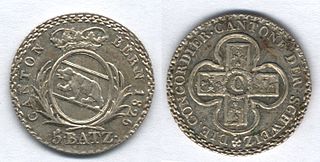
The Frank was the currency of the Swiss canton of Berne between 1798 and 1850. It was subdivided into 10 Batzen, each of 10 Rappen. It was worth 1⁄4th the French silver écu or 6.67 g fine silver.
The Frank was the currency of the Swiss canton of Fribourg between 1798 and 1850. It was subdivided into 10 Batzen, each of 4 Kreuzer or 10 Rappen. It was worth 1⁄4th the French silver écu or 6.67 g fine silver.
The Frank was the currency of the Swiss canton of St. Gallen between 1798 and 1850. It was subdivided into 10 Batzen, each of 4 Kreuzer or 16 Pfennig. It was worth 1⁄4th the French silver écu or 6.67 g fine silver.
The Frank was the currency of the Swiss canton of Solothurn between 1798 and 1850. It was subdivided into 10 Batzen, each of 4 Kreuzer or 10 Rappen. It was worth 1⁄4th the French silver écu or 6.67 g fine silver.
The Frank was the currency of the Swiss canton of Thurgau between 1798 and 1803. It was subdivided into 10 Batzen, each of 4 Kreuzer. It was worth 1⁄4th the French silver écu or 6.67 g fine silver.
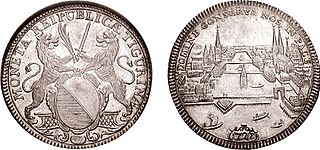
The cantons of the Old Swiss Confederacy used a currency system consisting of based on the old unit of the Schilling, with the Schilling divided into 4 Rappen or 12 Haller. The Taler was a large silver coin equivalent to 72 Schilling or 2 Gulden that came into use in the 16th century. The Batzen was an intermediate coin equivalent to 2 Schilling or 1⁄18Gulden.

The Frank was the currency of the Swiss canton of Zürich between 1806 and 1850. It was subdivided into 10 Batzen, each of 10 Rappen, with 3 Heller to the Rappen and 4 Rappen to the Schilling. It was worth 1⁄4th the French silver écu or 6.67 g fine silver.
The North German thaler was a currency used by several states of Northern Germany from 1690 to 1873, first under the Holy Roman Empire, then by the German Confederation. Originally equal to the Reichsthaler specie or silver coin from 1566 until the Kipper und Wipper crisis of 1618, a thaler currency unit worth less than the Reichsthaler specie was first defined in 1667 and became widely used after adoption of the Leipzig currency standard of 1690.
Blaffert was the name of two different types of historical European coin. It was also called the Blafferd or, in Upper German, the Plappart, Plappert or Blaphart. It derives from the French blafard meaning "pale" or "bright".